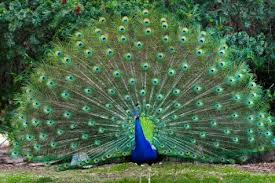One of the most magnificent sights in nature is the peacock's tail:

Scientists from Charles Darwin onward have wondered, "Why do peacocks have such a tail?"
The disadvantages are obvious:
- A complicated body part like that tail might require lots of DNA to describe.
- An average peacock tail has 200 feathers, which are shed and regrown every year. That uses up a lot of calories.
- Keeping the tail feathers clean and preened uses up a lot of calories.
- The tail is heavy; raising it and lowering it uses up a lot of calories, and makes flying more difficult.
- The tail is long, perhaps twice as long as the bird's body itself (see photos below).
- The tail makes the peacock slower, and more noticeable to predators.

Each of those reasons would seem to reduce the peacock's fitness and ability to survive and reproduce.
So you have to wonder: "How does the peacock survive and reproduce despite such a handicap?"
Many scientists have tried to answer this question, with varying degrees of success.
One scientist said, "That is the wrong question to ask."
Amotz Zahavi wondered, "Maybe the peacock survives and reproduces because of (not despite) such a handicap." This is called Handicap Theory. Handicap Theory says that a male who has such a handicap is signaling females: "Choose me! I am so good at surviving and reproducing that I can do so even with this handicap. I am more fit than other males. Choose me!"
How does this relate to investing and Seeking Alpha?
Investors have wondered, "Why do companies pay (and raise) a dividend?"
The disadvantages are obvious:
- Paying a dividend reduces available cash with the company, which could have been used for research and development, acquisitions, etc.
- Paying a dividend reduces the company's retained earnings.
- Paying a dividend reduces the price of the company's shares.
Each of those reasons would seem to reduce the company's fitness and ability to survive and grow.
So you have to wonder: "How does the company survive and grow despite such a handicap?"
Many investors have tried to answer this question, with varying degrees of success.
I say, "That is the wrong question to ask."
I wonder, "Maybe the company survives and grows because of (not despite) such a handicap." Handicap Theory says that a company who has such a handicap is signaling investors: "Choose me! I am so good at surviving and growing that I can do so even with this handicap. I am more fit than other companies. Choose me!"
Many dividend growth companies have paid (and raised) their dividend for 50 or more years. Diebold (DBD) has paid (and raised) their dividend for 60 consecutive years. Procter & Gamble (PG) has paid (and raised) their dividend for 57 consecutive years. Others in this elite group include AWR (59 years), PH (57 years), NWN (57 years), GPC (57 years), DOV (57 years), EMR (56 years), MMM (55 years), VVC (53 years), CINF (52 years), LOW (51 years), LANC (51 years), JNJ (51 years), KO (51 years), and CL (50 years). These Peacock Companies have demonstrated their ability to survive and grow over decades, during wars, natural disasters, recessions, etc. They appear to me to be more "fit" than other companies. When they say, "Choose me!", I do!
Disclosure: I am long JNJ, KO, PG. I wrote this article myself, and it expresses my own opinions. I am not receiving compensation for it (other than from Seeking Alpha). I have no business relationship with any company whose stock is mentioned in this article.